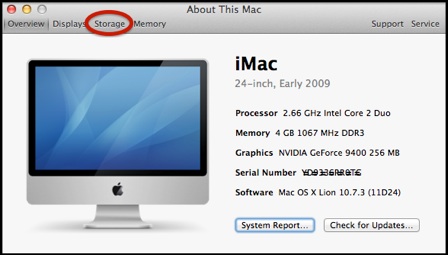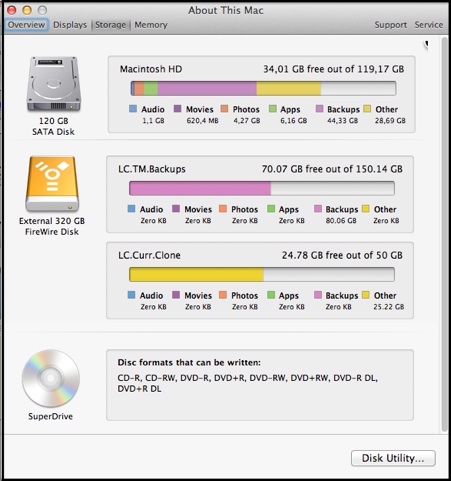OSX Tips
The Storage Display

Effective with Lion 10.7.x, if you click the Apple icon at the left of your menubar, select About This Mac, then More Info on the window that shows, you'll see the Overview window of the About This Mac display:

Unfortunately, the categories are not explained, and can be very misleading. There's no documentation of exactly what's counted in each category.
The categories are determined by Spotlight, not by where things are, but by what kind they are.
For example, your System folders contain some applications that you don't use directly. But they are included in the Apps section here; so that section may be larger than the size of your Applications folder.
Audio, Movies and Photos are similar; often larger than what you see in your user home folder, because some of them are in other places, in various system folders and/or other user's home folders.
Backups are two different things:
•On a laptop's Startup drive (or a data drive) that's backed-up by Time Machine, they're Local Snapshots and aren't a problem, as they're temporary and will be deleted automatically if necessary.
Think of these as (temporary) Versions for the files that don't have actual Versions.
But they're treated as free space by the Finder or Get Info, so those will show different amounts of free space than this display. See Time Machine FAQ #30 for details.
•On an external HD, they're normal Time Machine backups (as in the second item in the sample). Backups made by other apps are not included here, but will be in "Other."
Other is everything else: all kinds of stuff. Here's a partial list:
•System Stuff:
•The disk directory, catalogs, etc. that keep track of everything on the disk
•The File System Event Store, a log of changes to the files & folders
•OSX itself (the operating system)
•System work files (swap files, laptop sleepimage file, temporary files)
•System caches and logs
•Spotlight index
•The Versions database (previous versions of various files & documents)
•Files supporting various Apple apps
•In each User home folder:
•Preferences and settings
•Downloads
•User caches and logs
•Word processing documents, spreadsheets, etc
•Email and Contacts
•Calendars
•Browser history, bookmarks, cookies, web site icons
•Keychains
•Widgets
•Data for any apps that doesn't fall into one of the categories above
•Files supporting various apps
In addition, since the categories are determined by Spotlight indexing, if Spotlight isn't caught up, or you've excluded things from Spotlight indexing (via System Preferences > Spotlight > Privacy), the categories will be even less accurate. For example, the 3rd line in the sample is a "bootable clone" of an OSX system, but it's excluded, so everything is shown as Other.
Thus, do not worry about the size of any one category, especially Other.
If the amount of free space seems too small, consider three things:
•The folders you see in the Finder aren't everything on your system; there are many system folders, some hidden.
•If there's more than one user account on your Mac, one user (even an Admin user) won't see the accurate size of another user's home folder.
•Time Machine's Local Snapshots are treated as free space by the Finder or Get Info.
If there's still more on your system than you expect, see Where did my Disk Space Go?